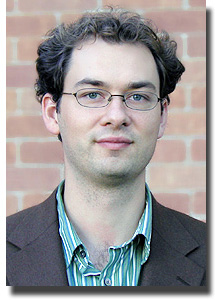Home » News » Introducing Virtual Reality for Interdisciplinary Applications
Introducing Virtual Reality for Interdisciplinary Applications
Posted by anderc8 on Monday, September 11, 2017 in News, Virtual Reality for Interdisciplinary Applications.

Ole Molvig, Assistant Professor of History
Written by Ole Molvig, Assistant Professor of History
The opportunity to co-teach a University Course on virtual reality (VR) with computer science professor Bobby Bodenheimer (someone with years of experience in the field) is tremendously exciting to me. You see, I am a historian – not exactly a field synonymous with cutting-edge computer technologies. Then again, I am a historian of science and technology, and my interests are always focused on the question of how deeply technical material is absorbed by others, be they elite scientists or newspaper readers. I began with Einstein’s theory of general relativity, today virtual reality, tomorrow likely artificial intelligence.
A class like Virtual Reality for Interdisciplinary Applications affords me yet another opportunity. While I will always bring my historical training with me to class, I am not teaching the history of virtual reality. I am teaching the lessons I have learned and taught from the history of science and technology – applied history if you will.
Playfulness and creativity matter deeply, so students begin by playing and then building games.
Multiple viewpoints are also critical, and interdisciplinary matters. Thus, we are mixing future engineers with future non-engineers to solve problems together. Faculty from across campus are serving as mentors in disciplines ranging from art history to machine learning, creating interdisciplinary projects that challenge our interdisciplinary teams.
Technical competence matters a lot, and not just for our future engineers. Everyone’s knowledge and capabilities are enhanced by technical experience, and there is no better way to learn a new skill than simply getting one’s hands dirty and playing around with it. And anyone can, and should, be technically confident – not just our future engineers.
These are the principles that have guided the construction of this course.
